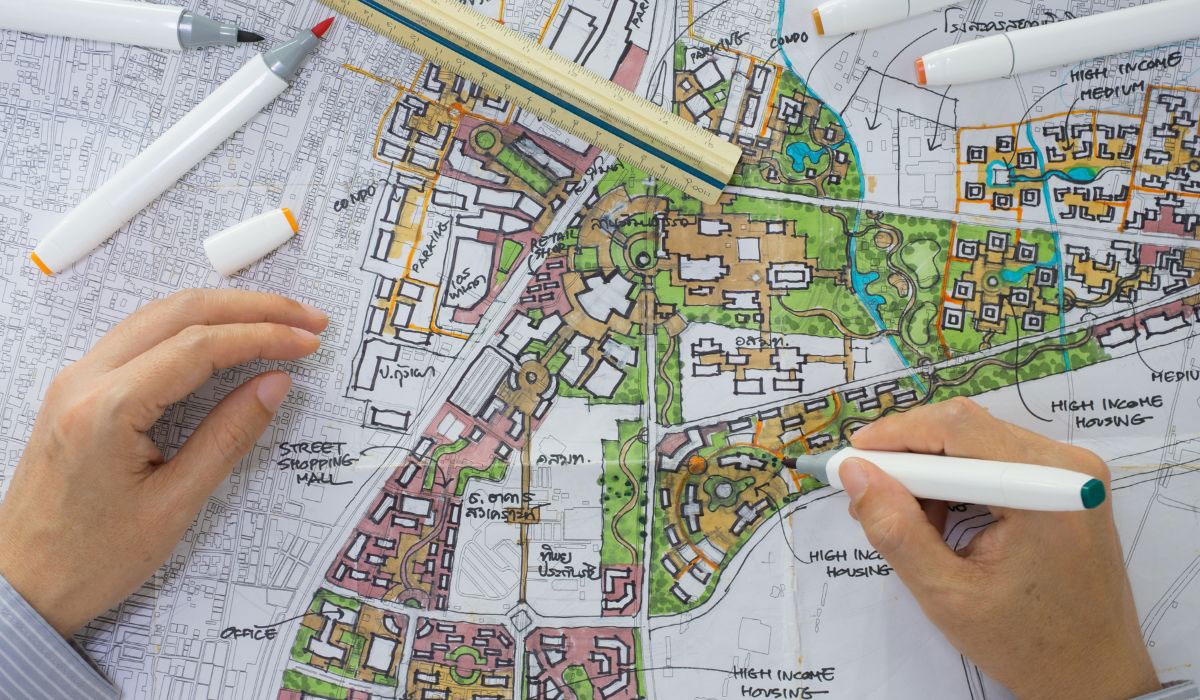In the landscape of urban development, the intersection of architecture and urban planning stands as a pivotal realm where collaborative approaches are essential for creating more functional, sustainable, and aesthetically pleasing environments.
The symbiotic relationship between urban planning and architecture in various forms ranges from strategic design interventions to community engagement initiatives. While exploring the synergies between these disciplines, most cities can navigate the complexities of urbanisation while fostering inclusive and vibrant communities.
In this blog, we will see the intersection of architecture and urban planning, along with collaborative approaches that advance this field.
The Intersection of Architecture and Urban Planning
Architecture, as the art and science of designing and constructing buildings and other physical structures, plays an important role in shaping the visual identity and spatial organisation of urban areas. On the other hand, urban planning focuses on the systematic design and regulation of land use, infrastructure, public spaces, and transportation within cities to ensure efficiency, resilience, and liveability.
At the intersection of these two disciplines lies a foundation of interdisciplinary collaboration, where architects and urban planners collaborate to address multifaceted urban challenges. The primary objective of the collaborative approach between architecture and urban planning is to create a human-centric environment that can prioritise the needs and aspirations of the community. The process starts with comprehensive research and analysis to understand the cultural, economic, social, and environmental dynamics.
Integrating inputs from different stakeholders, including residents, local authorities, environmental experts, and developers, helps in co-creating solutions that can resonate with the community’s values and aspirations. In addition, collaborative approaches facilitate the combination of innovative design principles and sustainable practices in urban development projects.
Collaborative Approaches to Architecture and Urban Planning
Energy-Efficient Buildings: Architects can bring their expertise in spatial design, material selection, and construction techniques to create environmentally responsible and energy-efficient buildings. Urban planners include principles of smart growth, mixed land use, and transit-oriented development to improve urban mobility, reduce carbon emissions, and improve overall quality of life. With interdisciplinary exchange, most cities can reduce the adverse impact of urbanisation on the environment while promoting equity and prosperity.
Community Engagement: Landscape architects, urban planners, and community activities can collaborate to repurpose existing infrastructure and integrate green spaces to foster community engagement. The project can revitalise surrounding neighbourhoods and attract new investments for adaptation by reusing sustainable urban regeneration.
Participatory Design Process: Other than physical interventions, collaborative approaches between architecture and urban planning can also include participatory design processes that can empower local communities to shape the future of neighbourhoods. By organising interactive design sessions and workshops, architects and planners can facilitate meaningful dialogue and co-design opportunities, allowing residents to articulate their needs and concerns.
Strategic Planning Initiatives: The collaborative approaches can go beyond individual projects to include wider policy frameworks and strategic planning initiatives. Most architects and urban planners can collaborate with researchers, policymakers, and advocacy groups to develop innovative planning policies, zone regulations, and design guidelines that can promote sustainable development. The alignment of regulatory frameworks with long-term strategic goals can allow cities to create an environment for investment, innovation, and equitable growth.
Also Read: What Are the Objectives of Architectural Planning?
How does a Masters in Urban Planning help in learning about the intersection of Architecture and Urban Planning?
M.Plan (Urban Planning) influencing how neighbourhoods, cities, and regions develop is the work of urban and regional planners. The Master of Planning (Urban Planning) degree programs bring together experts from planning, engineering, law, architecture, social work, public health, urban design, and other disciplines to build cities, tackle upgrading housing, and protect the environment while promoting community and economic development.
Further, this two-year full-time Master’s program encourages students to think independently and critically about city and regional planning problems, both domestically and internationally. It focuses on the importance of both a spatial and comparative perspective on planning.
Learning Outcomes of M.Plan (Urban Planning)
The M.Plan (Urban Planning) helps students in many ways. The learning outcomes of the program are mentioned below:
- Prepare balanced and critical analysis/arguments, attentive to particularities of place based on theoretical insights and empirical evidence.
- Students can undertake a well-supported diagnosis of the problem and opportunities in given urban development contexts in ways that can reframe strategic opportunities for action.
- Students learn to formulate systematic and well-supported strategic action planning proposals that are aimed at responding to complex urban development situations, including organisational and institutional development.
- The program allows students to build presentations, advocacy, and negotiation skills.
- Students can develop research skills, including interviewing, conceptual framework formulation, and the ability to analyse a range of information sources.
- Students can deliver group projects and negotiate the dynamics of working in diverse teams.
- The program can help with operating professionally in unfamiliar environments.
Program Highlights of M.Plan (Urban Planning)
The M.Plan (Urban Planning) program can explore theories and international practices in urban development policy, planning, and management that address contemporary spatial, social-economic, environmental, and political changes across the world.
In addition, the M.Plan (Urban Planning) program at Chitkara is a responsive program that adapts to the changing urban challenges and provides the skills for students to deal with them. The program highlights of M.Plan (Urban Planning) are mentioned below:
Focused Learning Approach: A precise focus is laid on helping students gain knowledge on how to carry out field investigations, collect data, and create plans for the growth of cities. The future graduates can learn how to look at a range of factors, including economic, legal, and environmental, to develop communication and analytical skills that are important for promoting their plans. This opens flexible career options for students in planning and development.
Industry-Endorsed Curriculum: The M.Plan (Urban Planning) program reflects a balance of theory and practice to equip students for a career where they can create contemporary cities that serve sustainable goals, functional needs, and aesthetic goals. The experiential curriculum focuses on planning studios and courses where you will acquire hands-on experience thinking, planning, and designing massive city layouts, along with proposing policies and recommendations for sustainable urban growth and development-related concerns.
Specialised Electives: You can choose from a range of electives as the program equips participants to work effectively as development planners/practitioners in urban contexts by offering a deeper understanding of the processes that generate urban change. The electives can help enhance student diagnostics and strategic capacities for responding to changes in a framework of socio-spatial and environmental changes.
The intersection of architecture and urban planning provides a perfect opportunity to address the multifaceted challenges of urbanization. By using the complementary expertise of architects and urban planners, cities can create inclusive, sustainable, and resilient environments to improve the quality of life for everyone.
Also, read this blog post: Exploring the Next Wave in Urban Planning
What’s more, participatory processes, innovative design interventions, strategic policy frameworks, and collaborative approaches can unlock the complete potential of urban development as a catalyst for positive social change.
If you want to become a successful professional in the field of urban development, then pursue a program such as M.Plan (UrbanPlanning) to gain the technical and analytical skills that can promote a deeper understanding of urban development planning. You will be able to gain a community-led and partnership-based understanding of urban development.






